In 2003, after a dozen years of airpower-based American military successes, things went awry. US ground troops occupying Iraq entered a four-year period of increasing losses and growing insurgency. By early 2007, Iraq appeared headed into an abyss.
The nation’s military strategy for counterinsurgency (COIN) was not working. The US had approached the war with the thought in mind that it needed to insert large numbers of conventional ground forces, that it needed to fight bloody force-on-force—even man-on-man—battles with the insurgents, and that it needed to physically occupy enemy territory. The watchword was “boots on the ground.”
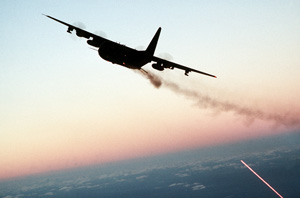 |
Above: An AC-130 gunship blazes away as it banks over Hurlburt Field, Fla. |
While US forces have enjoyed more success over the past year, there has been little fundamental change.
What if US military commanders were to approach the War on Terror from a totally different position? What if they accepted that the current problem is actually a civil war between the moderates and the radicals within global Islam? In that case, the West’s role would be to support the Islamic moderates, not just with military power but also all other forms of power.
In such a scenario, the logical commander would be the head of our intelligence apparatus, and his campaign plan would focus on psychological operations. The last thing the US would want to do is inflame local resentment by inserting tens of thousands of ground troops.
If the US military could break the lock that the boots on the ground and the “occupation of territory” mind-sets have on strategy and switch to a more air-centric joint strategy, the end result could very well be more success—at a lower cost in both casualties and dollars.
Many of the traditional beliefs regarding insurgencies—and thus our strategies for combating them—have failed.
Breaking out of the current mind-set will not be easy, however. There is a large canon of literature regarding insurgencies and counterinsurgency operations, and much of the opinion contained therein has become conventional wisdom.
In fact, none other than Army Gen. David H. Petraeus, who led US forces in Iraq during the surge of 2007 and 2008, helped set the COIN doctrine relegating airpower to a support role. In 2006, as a lieutenant general, Petraeus co-authored the Army-Marine Corps combined arms field manual for counterinsurgency. The influential document gave scarcely a mention to airpower.
The field manual relegated discussion of airpower to an annex comprising the final five pages of 335. It espoused the view that, for COIN, airpower is mostly useful for moving ground troops and providing ISR. As blunt instruments, air strikes should only be used “carefully.”
USAF Maj. Gen. Allen G. Peck, commander of the Air Force Doctrine Development and Education Center, subsequently said the field manual presented “a very two-dimensional view of how to fight a counterinsurgency.”
Perhaps most disturbing to airmen, the document also advocated placing airpower under the control of numerous ground commanders. “At the tactical level, air support requires a decentralized command and control system that gives supported units immediate access to available combat air assets,” it read.
Petraeus did, however, recognize the danger of conventional thinking. Successful COIN operations require militaries to “overcome their institutional inclination to wage conventional war,” he wrote.
As post-2003 Iraq has shown, the US needs new COIN strategies, with the logical solution being airpower-shaped joint operations. A look at the literature regarding insurgency and COIN reveals some verities (things that are essentially true), legends (things that are widely expected to be true but may not be), and surprises (curveballs that catch us unprepared). It also leads inevitably to some suggestions.
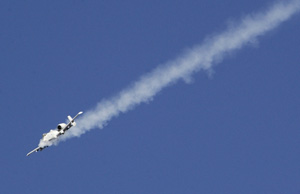 |
An A-10’s cannon blasts a target near Kirkuk, Iraq. |
1. Verities The most obvious truth about insurgent war is this: You are better off avoiding it. The world currently is wracked by some 80 insurgencies, large and small. Most of them do not concern America’s vital interests. We can afford to stay out. We need to give our forces a hand by not putting them into impossible situations in the first place.
Another verity: Intelligence is king. The US tends not to be very good at this. In October 2007, President Bush warned Iran to cease its ongoing nuclear program; yet, two months later the US Intelligence Community revealed it had been wrong for the previous four years—Iran did not have an active nuclear arms program. Lest we forget, intelligence errors contributed to the US decision to invade Iraq in 2003.
If intelligence is the king, then media is the queen. Recall three photos from the Vietnam War: a suspected Viet Cong terrorist executed on a street in Saigon by a pistol shot to the head; a young girl, naked, running away in terror from a napalm strike; and a US soldier using his lighter to set fire to a native hooch. In Iraq: the photos of Abu Ghraib and the photo of a US marine standing over a prostrate Iraqi and putting a bullet into him. These photos from Vietnam and Iraq may have represented extreme events, but that doesn’t matter. To a great extent, they defined those wars in the minds of millions of people worldwide. Despite repeated efforts, the US has had difficulty steering public perceptions about its war efforts.
Strategic vision is also key. There is an old military saying that brilliant tactics cannot overcome a flawed strategy. Kosovo in 1999 was a rare example of an exception to the rule. Despite a poorly conceived strategy imposed by NATO leaders, airmen were able to overcome it with their professionalism, creativity, and competence. American troops in Iraq are equally professional and creative; their lives depend on it.
Unity of command is crucial to the success of any military operation, including counterinsurgency. Moreover, in COIN, the military tool is only one, and usually a lesser, of the levers of power to be used. This usually favors putting a civilian in charge. A word of warning, though. Maxwell D. Taylor, US ambassador to South Vietnam in 1964 and 1965, was a retired general and former Chairman of the Joint Chiefs of Staff. He seemed the ideal choice for his position in Saigon, yet he failed. L. Paul Bremer III, a career diplomat, led the Coalition Provisional Authority in 2003-04. He also failed. In COIN, unity of command is a necessary but not sufficient factor in success.
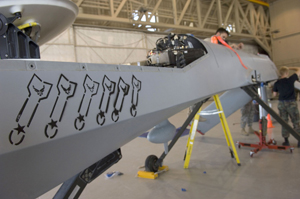 |
Airmen of the 432nd Aircraft Maintenance Squadron, Creech AFB, Nev., assemble an MQ-1 Predator that has returned from Afghanistan. The markings denote the number of Hellfire missiles it has fired. |
2. Legends Among all of the legends, the first and possibly most important is the claim that insurgencies are all about poverty and repression—that the insurgents therefore have a legitimate complaint. That is why, the argument goes, there must be a comprehensive COIN strategy that includes land reform, economic development, attacks on corruption, and so forth. In truth, Islamic fundamentalism is not about poverty and repression. To a large extent, Islamic fundamentalists are fighting against giving people freedoms. Witness the degree of poverty and repression that was present in Taliban-era Afghanistan.
Another legend: the need to “win hearts and minds.” We think it is a key to victory. Yet, this is one of those one-way streets seen frequently in insurgencies. The Viet Cong killers were not trying to win hearts and minds when they slaughtered 35,000 villagers in South Vietnam. Nor were the minions of al Qaeda that flew airliners into the World Trade Center and the Pentagon, or bombed the Madrid and London transit systems. Rather, insurgents deliberately use terror. Although it is important that democracies try to win over the population, it is not necessary for the insurgents to do so.
Legitimacy is often cited in the literature surrounding COIN. A relevant question, however, is who needs legitimacy? Is it the host nation or the insurgents? This is another one-way street. Unfortunately, it appears that when the West helps a host nation combat terrorism, the host nation is branded a puppet, but when the insurgents are helped by Russia, China, or Iran, they are not stigmatized.
Another legend: All of this stuff is new. We constantly hear that we live in a new world fraught with new enemies and new challenges. Not really. Insurgencies have been going on since ancient times, and the basic characteristics—guerrilla operations, the mixing of political, economic, and military factors, the need for sanctuaries and outside support—are recurring themes. It’s probably wise to note, however, that the current enemy is about as bad as they come. The 9/11 attacks and bombings of the trains in Europe were designed to deliberately slaughter as many innocent people as possible.
Here is the biggest legend of all, so big that it qualifies as a full-fledged myth: Success in COIN requires boots on the ground and occupation of territory. Use of conventional ground troops is very expensive despite limited effectiveness. Last year, the Congressional Budget Office stated that the cost thus far in Iraq was $604 billion and the cost will eventually surpass a trillion dollars. Compare that to the air campaigns of Northern and Southern Watch, which were amazingly successful but cost less than $1 billion annually.
Regarding cost: The new US Army-Marine Corps doctrine manual on counterinsurgency states that there must be a minimum of 20 counterinsurgents per 1,000 people. That perhaps sounds a bit unremarkable—until one does the math. Iraq has 27.5 million people. To ensure there are 20 counterinsurgents per 1,000 people would require 550,000 ground troops—three times the number already deployed there.
Moreover, in Vietnam the US did fulfill the minimum requirements. In fact, we had three times the number of boots on the ground supposedly necessary for success—525,000 US troops and another 675,000 South Vietnamese troops for a population of 20 million. Yet, all of those troops did not even detect, much less prevent, the Tet Offensive of 1968.
The strategy of putting tens of thousands of ground troops in harm’s way is very deadly—not only for our military forces, but for the civilian population we are trying to protect. US casualties in Iraq have gone in cycles. We are currently in a downward trend, but have been there before. While civilian deaths are notoriously hard to calculate and are prone to all sorts of biases and manipulations, there is no doubt civilian deaths in Iraq have been significant.
Even with the recent “surge” of US military forces into Iraq, it would be unwise to assume we are controlling the pace of military operations; our own literature states the insurgents control the tempo. And despite rhetoric about counterinsurgency being first and foremost a war of ideas, we nonetheless have chained ourselves to a strategy that emphasizes the traditional notions of occupation of territory and body counts.
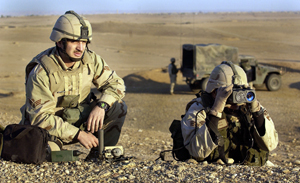 |
SrA. Josh Gianni (l) and SrA. Leo Ortiz track a target during an anti-insurgency operation near Kirkuk, Iraq. |
3. Surprises Westerners often assume that everyone has a fundamental yearning for democracy and freedom. It never occurs to us that millions of people do not. Rather, they willingly submit to what seems to Americans an oppressive way of life. Many do not want freedom of religion. They do not want women to have equal rights. They do not want freedom of speech, or the ability to watch whatever movies they wish, or to vote as they see fit. Freedom, as we define freedom, is not a universal desire.
Ideology rules: Westerners are unable to dent the intellectual and religious model that governs radical Islam. It is not about logic—as we define logic. For example: Two years ago, the cartoons in a Danish newspaper regarding Islam and Mohammed caused riots in several places around the world. Recall also the death sentence imposed by Iranian mullahs on British citizen Salman Rushdie for his novel, The Satanic Verses. Now recall the book and movie The Da Vinci Code. They were frontal assaults on sacred tenets of Roman Catholicism—yet there were no riots or fatwas calling for the death of the author. Americans simply do not think like Islamic fundamentalists and need to recruit intelligence operatives who do.
The war is a “limited war” only for us. This is another one of those surprises. The US may be fighting a limited war, but the Islamic fundamentalists are not. Democracies seek to protect innocents, avoid damaging mosques, and limit collateral damage, but insurgents do not show restraint. Most revolutions change the political structure, but Islamic fundamentalism seeks to overturn a country’s entire political, social, economic, and military structure.
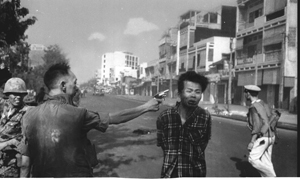 |
Gen. Nguyen Ngoc Loan, chief of the South Vietnamese national police, executes a suspected Viet Cong officer, Nguyen Van Lem, on a Saigon street in 1968. In the author’s view, this famous photo helped define Vietnam as a cruel and unjust war in the public mind. |
4. Suggestions The traditional means of dealing with insurgencies are not working. What we need are new ideas and strategies, not simply new tactics to implement old strategies. The United States needs to find a way to achieve its political goals with the least cost in blood and treasure.
The role for airpower in COIN is generally seen as providing airlift, ISR capabilities, and precision strike. This outdated paradigm is too narrowly focused and relegates airpower to the support role while ground forces perform the “real” work. Worse, marginalizing airpower keeps it in support of ground-centric strategies that have proved unsuccessful.
What are some other possibilities
First, it would be useful to revisit the “air control” operations employed by the Royal Air Force in the Middle East in the 1920s and 1930s. These operations were not always successful in objective military terms, but they were unusually successful in political terms, in part because they carried a low cost in both financial and casualty terms. In many ways these operations were the precursors of “Watch” operations over Iraq in the 1990s.
In Northern Watch and Southern Watch, the US-led coalition flew more than 300,000 sorties over Iraq between 1991 and 2003 while suffering no combat losses and with a cost less than $1 billion per year. The result: Saddam Hussein was contained. Not only could he not threaten his neighbors, he was unable to build facilities for weapons of mass destruction.
American airpower enjoyed other successes of a similar nature. The US-led victories in Bosnia (1995), Kosovo (1999), Afghanistan (2001), and Iraq (2003) were achieved using a combination of air and space power, special operations forces, indigenous ground forces, and robust intelligence assets.
Until the start of the current Iraq War, conventional US ground troops played only a minor role. This was not the preferred strategy of the ground officers, but it proved repeatedly successful.
Compared to 1991 or even 2003, today’s Air Force has more sophisticated and effective sensor aircraft and satellites that can produce even greater results. Pushing to develop new ways to sniff out weapons of mass destruction, detect IEDs, and operate in urban environments will help, and USAF already has the benefit of lessons from five years in Iraq.
DOD’s leaders should re-examine the paradigm that was so successful in Bosnia, Kosovo, Afghanistan, and Iraq. That was the use of air and space power, combined with SOF, indigenous ground forces, and overwhelming ISR. Given the outstanding results already demonstrated, an air-centric joint COIN model should be one of the first options for America’s military and political leaders.
Phillip S. Meilinger is a freelance writer living near Chicago. He is a retired Air Force command pilot with a Ph.D. in military history. His most recent article for Air Force Magazine was “The 90-Year Tanker Saga,” February 2007.